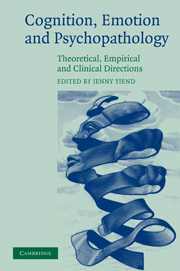Book contents
- Frontmatter
- Contents
- List of contributors
- An introduction and synthesis
- Andrew Mathews: a brief history of a clinical scientist
- Part I Theoretical approaches
- 1 The positive and negative consequences of worry in the aetiology of generalized anxiety disorder: a learning theory perspective
- 2 Trait anxiety, repressors and cognitive biases
- 3 A cognitive-motivational perspective on the processing of threat information and anxiety
- 4 Maintenance or capture of attention in anxiety-related biases?
- Part II Empirical directions
- Part III Clinical perspectives
- Index
3 - A cognitive-motivational perspective on the processing of threat information and anxiety
Published online by Cambridge University Press: 23 November 2009
- Frontmatter
- Contents
- List of contributors
- An introduction and synthesis
- Andrew Mathews: a brief history of a clinical scientist
- Part I Theoretical approaches
- 1 The positive and negative consequences of worry in the aetiology of generalized anxiety disorder: a learning theory perspective
- 2 Trait anxiety, repressors and cognitive biases
- 3 A cognitive-motivational perspective on the processing of threat information and anxiety
- 4 Maintenance or capture of attention in anxiety-related biases?
- Part II Empirical directions
- Part III Clinical perspectives
- Index
Summary
We are pleased to contribute a chapter describing our work to this Festschrift for Andrew Mathews, who has made a major contribution to the evaluation and development of cognitive theories of anxiety, as well as being among the first to apply paradigms from cognitive-experimental psychology to the study of cognitive biases in clinical and non-clinical anxiety. Indeed, research by Andrew and his colleagues has been particularly influential in this field during the last twenty or so years (e.g. Mathews, 1990; Mathews & MacLeod, 1985, 1994, 2002; MacLeod, Mathews & Tata, 1986; Mathews & Mackintosh, 1998, 2000). Such research has addressed a variety of questions. For example:
Do biases for threat information operate throughout information processing, or only in specific cognitive operations (e.g. stimulus evaluation, selective attention, memory)?
Do cognitive biases operate automatically, independently of awareness?
Do cognitive biases play a role in causing and/or maintaining clinical anxiety states? If so, which specific biases (e.g. biases in evaluative or attentional processes) play such a role?
What is the nature of cognitive biases in non-clinical anxiety, and how do they differ from biases associated with clinical anxiety?
Do different types of cognitive bias operate in different anxiety disorders (e.g. generalized anxiety disorder (GAD) versus social phobia)?
Are anxiety and depression characterized by different patterns of cognitive bias?
Although there have been considerable advances, answers to many of these questions remain incomplete. In this chapter, because of space limitations, we will only be able to consider a few notable issues mainly arising from research into attentional biases in anxiety, as this has been a core aspect of the research carried out by Andrew and his colleagues.
- Type
- Chapter
- Information
- Cognition, Emotion and PsychopathologyTheoretical, Empirical and Clinical Directions, pp. 68 - 85Publisher: Cambridge University PressPrint publication year: 2004
- 13
- Cited by



